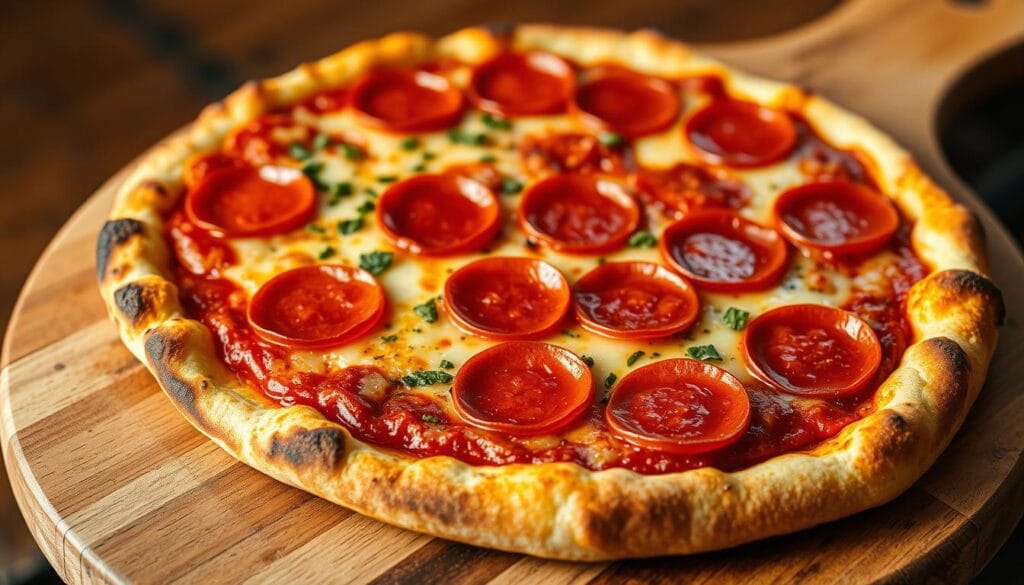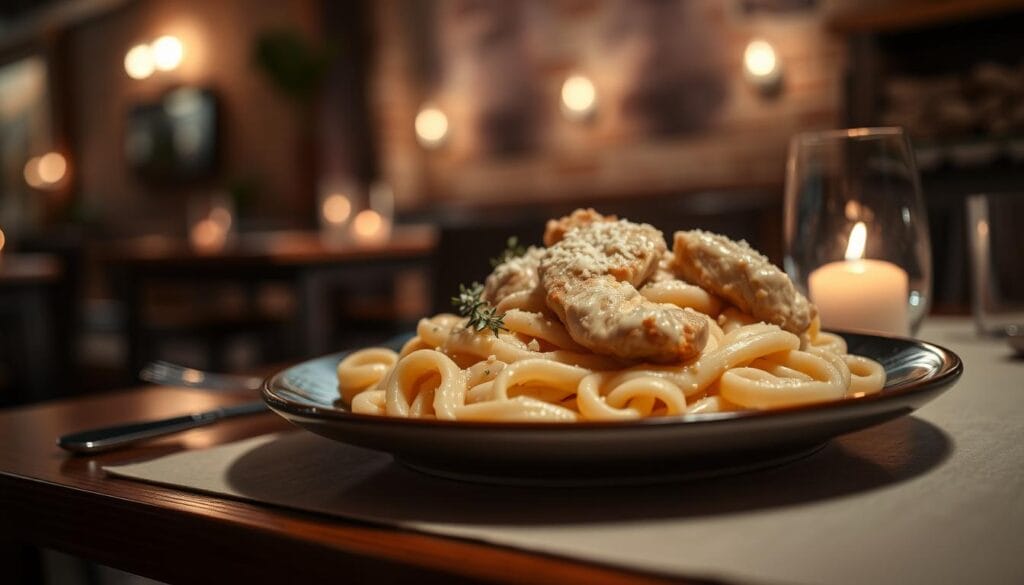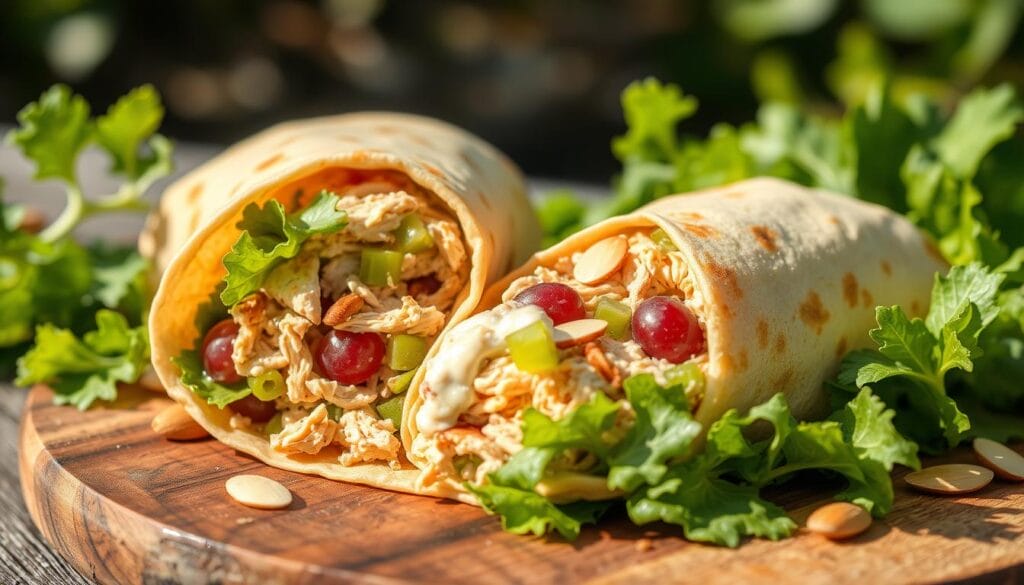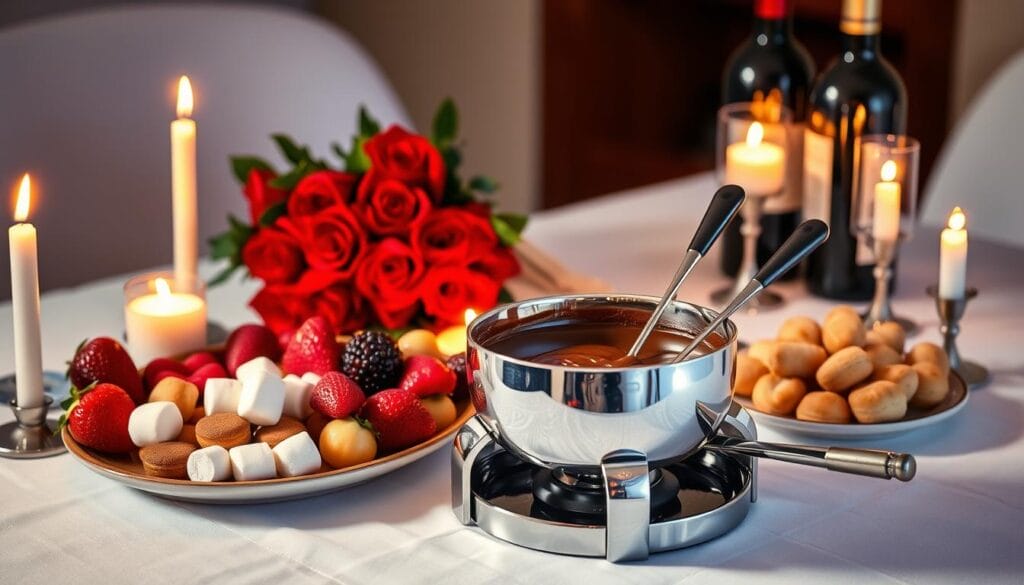What makes homemade pepperoni pizza so irresistible? Is it the flavors, the crust, or something else? Start by checking out homemade pepperoni pizza recipes for ideas. You’ll learn about the importance of quality ingredients, like flour and cheese.
Introduction to Homemade Pepperoni Pizza
Make a delicious homemade pepperoni pizza in just 30 minutes of prep and 18 to 20 minutes of cooking. The secret is in the details, like a crispy crust and flavorful sauce. Follow simple steps and use the right ingredients to make a pizza that’s as good as your favorite restaurant’s.
Key Takeaways
- You can make a delicious homemade pepperoni pizza with a crispy crust and cheesy goodness in under an hour.
- Quality ingredients, such as fresh mozzarella and pepperoni, are essential for a great homemade pepperoni pizza.
- A homemade pepperoni pizza can be customized with your favorite toppings, from classic pepperoni to more adventurous options.
- With a few simple steps and the right ingredients, you can create a homemade pepperoni pizza that’s perfect for any occasion.
- For more information on mastering the art of flavor, visit mastering the art of flavor to learn how to perfectly season and balance your dishes.
- Homemade pepperoni pizza is a versatile dish that can be enjoyed by people of all ages and backgrounds.
The Origins of Pepperoni Pizza
Exploring Italian recipes reveals that pepperoni pizza is a classic from the United States. The story of pizza history is both rich and fascinating. It shows how toppings and ingredients have changed over time.
To learn about pepperoni pizza, we must look at pizza’s early days. We see how pepperoni became a favorite topping.
Pepperoni was first mentioned in 1908 in The Gateway magazine. But it wasn’t until the 1910s that it became popular. The word “peperoni” means large bell peppers in Italian. This shows how different cultures have their own topping preferences.
Looking into the world of Italian recipes, we see pepperoni pizza is loved in America. Its rich pizza history and tasty ingredients make it a favorite.
A Brief History of Pizza
Pizza’s history goes back to ancient times. But the modern pizza came from Italy and was popularized in the U.S. by Italian immigrants. The first pizzeria in the U.S. was Gennaro Lombardi’s in 1905. It quickly became a hit for its taste and price.
The Rise of Pepperoni as a Topping
Pepperoni became a top choice in the U.S. in the mid-20th century. This was thanks to chain pizzerias like Pizza Hut and Domino’s. These chains made pepperoni pizza widely available. Today, pepperoni is the most loved pizza topping in the U.S. Its history continues to interest food fans worldwide.
Essential Ingredients for Homemade Pepperoni Pizza
Making a tasty homemade pepperoni pizza needs the right ingredients. You’ll need pizza dough, sauce, cheese, and pepperoni. Start with bread flour, sugar, yeast, salt, warm water, olive oil, garlic, and crushed red pepper flakes for the dough.
A homemade pizza sauce is key, and you can make it with fresh tomatoes. Choose low-moisture mozzarella cheese and high-quality pepperoni for flavor and spice.
Consider adding different cheeses like parmesan or gorgonzola. You can also try mushrooms, onions, or bell peppers as toppings. Experiment to find your favorite mix. With the right ingredients and practice, you’ll soon make great homemade pepperoni pizzas.
Step-by-Step Guide to Making Pizza Dough
To make a tasty homemade pizza, start with great pizza dough. Making dough from scratch is easy. With a stand mixer and dough hook, your dough is ready fast. The secret to perfect dough is using the right ingredients and a simple recipe.
Warm water is key to activate yeast. The water should be between 110 to 115 degrees Fahrenheit. You’ll also need 2 1/4 teaspoons of active dry yeast. Plus, add 1 teaspoon of granulated sugar to help the yeast.
- 3 cups of all-purpose flour
- 1 teaspoon of kosher salt
- 1 tablespoon of extra virgin olive oil
- 1 teaspoon of granulated sugar
- 2 1/4 teaspoons of active dry yeast
- 1 cup of warm water
Follow a simple recipe and use the right ingredients for a delicious homemade pizza. Always use fresh ingredients and follow food safety when handling and storing your dough.
How to Prepare the Perfect Pizza Sauce
Making the perfect pizza sauce is key to a tasty homemade pizza. You can use simple things like crushed tomatoes, garlic, and olive oil. First, pick the right tomatoes for your pizza sauce. Canned tomatoes are best because they’re less acidic than fresh ones.
A basic tomato sauce recipe adds 0.5 teaspoons of sugar. This balances the taste without making it too sweet. San Marzano tomatoes are sweeter and less acidic, so you might not need sugar. With these ingredients, you can make a tasty pizza sauce for your homemade pizza.
Here’s a quick look at the recipe:
- 1 can (28 oz) of tomatoes, preferably Roma or San Marzano variety
- ¼ cup of olive oil
- 3 large cloves of garlic, minced
- 1 teaspoon of dried oregano
- 2 sprigs of fresh basil or 1 teaspoon of dried basil
- 1 teaspoon of kosher salt
- Optional: ¼ teaspoon crushed red pepper flakes

The sauce needs to simmer for at least 30 minutes. But, simmering for up to 1 hour makes the flavor even better. With this recipe, you can make a delicious homemade sauce for your pizza. It’s great as a pizza sauce or a tomato sauce.
Selecting the Best Cheeses for Pizza
Choosing the right pizza cheese is important. Mozzarella is a top pick because it melts well and stretches. A standard pizza slice has about 21g of cheese, and mozzarella is a favorite in America.
You can also try other cheeses like provolone, fontina, or a mix of different ones.
Some cheeses, like cheddar and Gouda, have strong flavors. Others, like mozzarella and provolone, taste milder. The way cheese melts can also vary. Some melt well and stretch, while others just puddle.
Think about the pizza type and flavor you like when picking cheese. Fresh mozzarella is perfect for Neapolitan pizza. A mix of mozzarella and provolone is great for New York-style pizza.
Don’t be afraid to mix cheeses to find your favorite. With so many options, you’ll find the perfect cheese for your pizza.
The Role of Pepperoni in Your Pizza
Choosing the right pepperoni for homemade pizza is key. Pepperoni adds flavor and spice. It’s made from pork and beef, giving it a special taste.
A YouGov poll found 50% of Americans love pepperoni. It’s the most popular topping after extra cheese.
There are many pepperoni types to pick from. You can choose from smoked, spicy, or turkey pepperoni. The right thickness, between 3 to 6 millimeters, ensures even cooking and texture.
It’s important to buy quality pepperoni. Look for brands like Hormel and Wellshire Farms. Keep it in the fridge or freezer to keep it fresh.
When picking pepperoni, think about these things:
- Flavor profile: Pick one that goes well with your sauce and cheese.
- Texture: Choose a pepperoni that’s crunchy but also chewy.
- Quality: Go for brands known for using good ingredients.
By considering these points, you can make a tasty homemade pepperoni pizza. Pepperoni’s rich flavor and spicy kick make it a great choice. With the right pepperoni types and storage, you can enjoy it for weeks.
Assembly: Putting Your Pizza Together
Making your own pepperoni pizza is like a fun art project. It needs focus and a bit of practice. You’ve got your dough, sauce, and toppings ready. Now, it’s time to put it all together.
Spreading the sauce is a key step in pizza assembly. Make sure to leave a little room around the edges without sauce. This helps the crust stay nice and crispy. Then, start adding your toppings, but don’t overdo it.
When making a homemade pizza, think about the crust thickness. Thicker crusts can hold more toppings but might not cook as well as thinner ones.
- Spread the sauce evenly, leaving room around the edges.
- Layer your toppings in a way that balances flavors and textures.
- Choose the right crust thickness for your toppings and cooking method.
Baking Your Homemade Pepperoni Pizza
When baking pizza, the oven temperature is key. You want a crispy crust and melted cheese. Preheat your oven to about 450°F for homemade pizza.
Think about using a pizza stone for a crisper crust. A baking sheet works too, but a pizza stone is better for pizza baking. The baking time varies based on crust thickness and toppings. Usually, it takes 14-18 minutes, with 6-8 minutes without toppings and 8-10 minutes with.

Choosing the Right Oven Temperature
The oven temperature is very important for a perfect crust. A temperature of 450°F is best for oven temperature. You can try different temperatures to see what works best for your homemade pizza.
Baking Time for Perfect Crispiness
To get the perfect crispiness, watch the baking time closely. The time needed depends on crust thickness and toppings. On average, it’s 14-18 minutes.
Tips for Achieving a Crispy Crust
To get a crispy crust on your homemade pepperoni pizza, focus on a few important things. Pre-baking the dough, or pre-cooking, sets the crust’s structure before adding toppings. This step is key to avoid a soggy crust from the sauce and toppings.
Adding cornmeal also helps make the crust crispy. Cornmeal gives a crunchy texture and helps the crust brown better. With the right pizza crust techniques, you can get the perfect mix of crunch and taste.
- Pre-baking the dough at a high temperature (around 450-500 degrees Fahrenheit) for a few minutes.
- Using a pizza stone in the oven to absorb moisture and distribute heat evenly.
- Avoiding overloading the pizza with toppings to prevent a soggy crust.
By using these tips and techniques, you can make a tasty homemade pepperoni pizza. It will have a crispy crust that will make you happy.
Enhancing Flavor with Additional Toppings
Homemade pepperoni pizza gets better with the right pizza toppings. Adding additional toppings brings new tastes and textures. But, it’s key to mix them well for the best flavor enhancement.
Start with toppings like mushrooms, onions, and bell peppers. They add flavor and texture that makes the pizza better.

When mixing additional toppings, balance is key for the best flavor enhancement. Begin with sauce and cheese. Then, add toppings that mix well together.
Serving and Enjoying Your Pizza
Now that you’ve made your delicious homemade pepperoni pizza, it’s time to think about pizza serving. The right wine can make your pizza taste even better. Try a medium-bodied red wine, like Chianti or Merlot, with your pizza.
For slicing techniques, you want to enjoy every bite. Use a pizza cutter or sharp knife for thin, even slices. This way, you’ll get the most out of your homemade pepperoni pizza.
- Use a pizza stone or a baking sheet to serve your pizza, as this will help keep it warm and crispy.
- Consider adding some extra toppings, such as fresh basil or oregano, to give your pizza a bit more flavor.
- Don’t be afraid to get creative with your pizza serving, and try out different combinations of toppings and wine pairings to find your favorite.
Common Issues with Pizza Dough and How to Troubleshoot Them
When it comes to making pizza, the dough is the foundation. But, sometimes, things don’t go as planned. In this section, we’ll explore some common issues that can arise with pizza dough and provide troubleshooting tips to help you overcome them.
1. Dough Not Rising
One of the most frustrating problems is when your dough doesn’t rise as expected. This can be due to a few reasons, such as:
- Insufficient yeast: Make sure you’re using the right amount of yeast for the size of your dough.
- Incorrect temperature: Yeast thrives in warm temperatures, so ensure your dough is in a room with a consistent temperature between 75°F and 80°F.
- Old yeast: Yeast has a limited shelf life, so check the expiration date and use fresh yeast for the best results.
To troubleshoot, try adjusting the yeast amount or checking the temperature of your environment. If the problem persists, it might be worth trying a different type of yeast or consulting a baking expert.
2. Dough Too Sticky
On the other hand, if your dough is too sticky, it can be challenging to work with. This issue can arise from:
- Excess moisture: Make sure you’re not adding too much water to your dough. Start with a smaller amount and gradually add more as needed.
- Incorrect flour ratio: The ratio of flour to water can affect the dough’s texture. Try adjusting the ratio to achieve the right consistency.
- Warm environment: Yeast dough can become sticky if the environment is too warm. Try placing the dough in a cooler area to help it come together better.
To troubleshoot, try reducing the amount of water or adjusting the flour ratio. If the problem persists, you can also try adding a small amount of flour to the dough to help it become more manageable.
3. Dough Too Dry
Conversely, if your dough is too dry, it can be difficult to shape and may not have the right texture. This can be caused by:
- Insufficient moisture: Make sure you’re using the right amount of water in your dough. If it’s too dry, it can be challenging to shape and may result in a dense crust.
- Incorrect flour ratio: Similar to the sticky dough issue, the ratio of flour to water can affect the dough’s moisture level. Try adjusting the ratio to achieve the right consistency.
- Overworking the dough: Overworking the dough can cause it to become dry and dense. Try to handle the dough gently and avoid over-kneading.
To troubleshoot, try adding a small amount of water to the dough to help it become more pliable. If the problem persists, you can also try adjusting the flour ratio or consulting a baking expert for further guidance.
By addressing these common issues and troubleshooting tips, you can overcome any challenges you may face with your pizza dough. Remember, practice makes perfect, so don’t be discouraged if it takes a few attempts to get it just right.

| Issue | Causes | Troubleshooting Tips |
|---|---|---|
| Dough Not Rising | Insufficient yeast, incorrect temperature, old yeast | Adjust yeast amount, check temperature, use fresh yeast |
| Dough Too Sticky | Excess moisture, incorrect flour ratio, warm environment | Reduce water amount, adjust flour ratio, place in cooler area |
| Dough Too Dry | Insufficient moisture, incorrect flour ratio, overworking the dough | Add water, adjust flour ratio, handle gently |
FAQ
What are the key characteristics of homemade pepperoni pizza?
Homemade pepperoni pizza is known for its crispy crust and cheesy goodness. It also has a spicy pepperoni topping. The recipe gives you all you need to make the perfect homemade pepperoni pizza.
What is the history of pepperoni pizza?
The article talks about how pepperoni pizza came to be. It explains how pepperoni became a favorite topping in Italian-American cuisine.
What are the essential ingredients for homemade pepperoni pizza?
You’ll need dough, sauce, cheese, and pepperoni for homemade pepperoni pizza. The article gives tips on choosing the right ingredients. It also suggests variations and substitutions.
How do you make the perfect pizza dough?
The article guides you through making pizza dough. It covers mixing, kneading, rising, and shaping. It also shares tips for a perfect crust and avoiding mistakes.
How do you prepare the perfect pizza sauce?
The article teaches you how to make the perfect pizza sauce. It talks about choosing tomatoes, cooking methods, and adding flavor. It offers tips for a delicious, authentic sauce.
What are the best cheese options for homemade pepperoni pizza?
The article explores pizza cheese options. It discusses mozzarella, other cheeses, and blending. It gives tips for the perfect cheese mix for your pizza.
What role does pepperoni play in homemade pepperoni pizza?
The article explains pepperoni’s role in homemade pepperoni pizza. It covers types, thickness, and where to buy quality pepperoni. It offers tips for choosing the best pepperoni.
How do you assemble the perfect homemade pepperoni pizza?
The article shares tips on assembling homemade pepperoni pizza. It covers spreading sauce, layering toppings, and choosing crust thickness. It helps you balance flavors and textures.
What are the best techniques for baking homemade pepperoni pizza?
The article discusses baking techniques for homemade pepperoni pizza. It talks about oven temperature, baking time, and using a pizza stone or baking sheet. It offers tips for a perfect crust and avoids common mistakes.
How can you achieve a crispy crust for homemade pepperoni pizza?
The article shares tips for a crispy crust. It covers pre-baking, thin vs. thick crusts, and the role of cornmeal. It helps you avoid common mistakes.
What additional toppings can enhance the flavor of homemade pepperoni pizza?
The article talks about adding extra toppings to enhance flavor. It discusses popular toppings, balancing flavors, and combining them well. It offers tips for choosing the right toppings.
How should you serve and enjoy your homemade pepperoni pizza?
The article shares tips on serving and enjoying homemade pepperoni pizza. It talks about pairings, slicing, and sharing with family and friends. It helps you make the most of your pizza.
What are some common issues that can arise when making homemade pepperoni pizza?
The article discusses common issues like dough not rising and soggy crusts. It offers solutions and tips for a perfect homemade pepperoni pizza.




